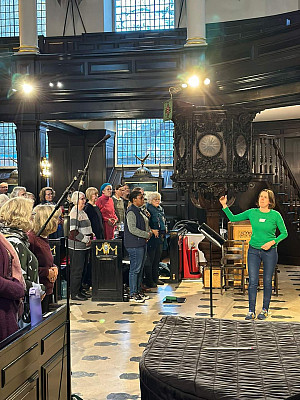
Spanish Renaissance Music in London: A Bucket List Experience for Dr. Holly Hubbs
Dr. Holly Hubbs had the opportunity to travel to London and participate in a workshop on choral music of the Spanish Renaissance at the historic St. Clement Danes Church.
William F. Heefner Professor of Music Holly Hubbs recently fulfilled a dream by participating in a workshop on choral music of the Spanish Renaissance at the historic St. Clement Danes Church in London. The workshop gave Hubbs the chance to explore the complexities of Renaissance vocal polyphony, a genre she has long appreciated as a listener, but never had the chance to perform. The workshop was organized by the renowned choral scholars of the early music ensemble Stile Antico.
“It was a ‘bucket-list’ experience,” Hubbs shared. “Eight-part vocal polyphony is not something you often find outside of specialist circles, so to have a chance to perform the music, rather than just listen, was a real treat!”
The atmosphere and experience was dramatically enhanced by the setting of the workshop. The original St. Clement Danes Church, destroyed in World War II, was rebuilt in 1958, and now serves as a museum and monument to the Royal Air Force. “It’s a space with a tragic but wonderful story,” Hubbs remarked, noting the beauty and history of the venue where the workshop and performance took place.
Learning from the Masters
Working with Stile Antico was an unforgettable aspect of the experience due to the deep knowledge and engaging teaching style of the ensemble members. Beyond conducting the choir, the scholars provided rich program notes on the composers and historical context of the repertoire.
One particularly fascinating insight was about Hernando Franco, a Spanish composer who traveled to Mexico and became the maestro di capilla at Mexico City. “Franco set some of his motets in the Nahuatl language, adapting a more homophonic style to suit the musical skills and tastes of the local population,” Hubbs explained. This unique cultural exchange deepened her understanding of the global reach of Renaissance music and its adaptability to different communities and traditions.
Bringing the Renaissance to Ursinus
As an example of a lifelong learned and passionate educator, Hubbs is eager to bring what she learned back to her classroom at Ursinus College. Her Music History and Culture 1 course dedicates several weeks to exploring Renaissance vocal music, and her workshop experience will undoubtedly enhance these lectures.
“I also plan to share a slideshow of instrument photos from my side trip to the Victoria and Albert Museum,” Hubbs added. The beautifully decorated violins, harpsichords, lutes, and other instruments in the museum’s collection show the opulent artistry of the Baroque period. “It’s a great way to demonstrate to students that Baroque excess extended beyond the music to include the instruments as well!”
A Lasting Impact
For Hubbs, the workshop was more than just a professional development opportunity—it was a profound personal experience that bridged her scholarly interests and passion for performance. Through immersing herself with the music of composers like Francisco Guerrero, Cristóbal de Morales, Alonso Lobo, and Hernando Franco, she not only gained new insights but also fulfilled a dream of performing Renaissance vocal polyphony in a historic and meaningful setting.
Hubbs looks forward to continuing to share her passion for early music with students and colleagues, ensuring that the richness of the Spanish Renaissance continues to inspire and resonate.
Quick Links
Contact
Brian D. Langdon
Music Department Publicity Manager
blangdon@ursinus.edu
